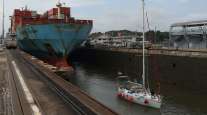Trains Carrying Crude in Canada to Face Tougher Safety Standards

Canada is strengthening proposed new safety standards for rail cars carrying crude oil, requiring thicker steel and other improvements after a 2013 derailment killed 47 people.
The latest Transport Canada proposals, published online March 11, go beyond earlier announcements by requiring rail cars carrying crude to have thicker steel, full “head shields,” mandatory thermal “jacket” protection among other upgrades. Canada continues to work with the U.S. on rail standards, the document said, adding the U.S. will make its own decisions.
In its online update, Transport Canada said the Transportation Safety Board had pushed for improvements from those initially published in January 2014. Transport Minister Lisa Raitt announced the new standards, which are still subject to federal cabinet approval, in parliament March 11.
The standards create “a new class of tank car specifically designed to transport flammable liquids by rail,” said Zach Segal, a spokesman for Raitt. The updated proposals were published March 11 for transparency and “as part of the department’s ongoing discussions with industry,” he said, adding, “I want to emphasize that this work is being conducted in an expedited manner.”
The new proposed standards for what would be called TC-117 cars would apply to new cars and see some existing cars retrofitted. Rail cars carrying flammable liquids, such as crude, would need to be “jacketed” with an extra layer of protection against extreme heat and have steel at least 9/16ths of an inch thick, an increase from earlier proposals.
Cars would also need full “head shields” to protect the front of the rail car from being punctured, added protection atop the car and a new valve at the bottom.
TSB spokesman Chris Krepski said the agency was reviewing Transport Canada’s latest proposal as it assesses changes made after the the 2013 derailment of a train carrying oil in Lac-Mégantic, Quebec, that killed 47 people.
Canada’s two major railways welcomed the new suggested standards.
“The new standards represent a clear advance in tank car safety,” Mark Hallman, a spokesman for Canadian National Railway Co., said in a statement. He noted that the “vast majority” of tank cars carrying crude are owned by shippers or rail-car leasing companies. “CN is committed to running a safe railway and complies fully with federal government regulations governing the transportation of dangerous goods.”
Martin Cej, a spokesman for Canadian Pacific Railway Ltd., said its chief executive officer, E. Hunter Harrison, has long advocated for safer tank cars. “CP welcomes any progress towards full implementation of safer tank car standards,” Cej said in a statement.
Under the proposed guidelines, the safer tank car standards would be phased in to replace “non-jacketed DOT-111” cars carrying crude by May 2017, and those carrying ethanol by May 2020.




